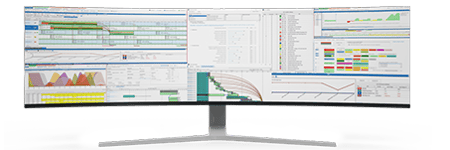Maximizing Asset Capacity and Flexibility in Medical Manufacturing through Strategic Integration
In the medical manufacturing sector, the demands for high production standards, rapid response to market shifts, and stringent regulatory compliance place enormous pressure on plant managers. Striking a balance between asset capacity and operational flexibility is crucial for optimizing production without overextending resources or risking inefficiencies. Integrating advanced planning tools like PlanetTogether with enterprise systems like SAP, Oracle, Microsoft, Kinaxis, or Aveva offers powerful avenues to enhance asset utilization, manage capacity effectively, and foster adaptability. This article explores strategies for plant managers in medical manufacturing to leverage such integrations, meeting both current demands and future scalability requirements.

The Challenge of Capacity and Flexibility in Medical Manufacturing
Medical manufacturing operates in a unique environment where variability in demand, high stakes for quality, and rapid technological advancements continuously challenge production processes. Here are key challenges plant managers face in managing asset capacity and flexibility:
Surges in Demand: New medical advancements or health crises can create unpredictable spikes in demand, requiring rapid scalability.
Strict Regulatory Requirements: Compliance with regulatory bodies (such as the FDA or EMA) limits flexibility by imposing specific production standards.
High-Cost, High-Specification Assets: Medical manufacturing requires specialized equipment, which is costly to replace or reconfigure for different production requirements.
Balancing Asset Utilization and Maintenance: Equipment downtime for maintenance can delay production, but overuse without timely maintenance increases the risk of equipment failure.
Addressing these challenges demands a balanced approach to asset utilization that is adaptable, reliable, and efficient. Integrated systems enable plant managers to streamline asset planning and leverage real-time data to improve decision-making for both capacity management and flexibility enhancement.
![]()

Leveraging Integration Between PlanetTogether and ERP/SCM Systems
PlanetTogether, a leader in advanced planning and scheduling (APS) systems, provides capabilities for optimizing production schedules and ensuring resource availability. When integrated with ERP or SCM systems like SAP, Oracle, Microsoft, Kinaxis, or Aveva, PlanetTogether expands its utility by accessing broader enterprise data and providing cross-functional insights. This integration facilitates the following enhancements:
Real-Time Visibility into Capacity and Asset Health
When PlanetTogether integrates with an ERP system such as SAP or Oracle, plant managers can gain instant insights into the capacity of their assets, helping them assess current workloads and available production capacity. For instance, data from SAP’s asset management module can inform PlanetTogether's scheduling algorithms about maintenance schedules, avoiding overloading machines close to maintenance or downtime.
Example: Suppose a critical production line is scheduled for maintenance within the next week. Integrated scheduling from PlanetTogether and SAP can help reschedule non-critical production to other assets, maintaining output without risking production halts. Moreover, this real-time visibility enables a proactive response to asset health, ensuring that capacity planning aligns with asset conditions.
Streamlined Production with Adaptive Scheduling
PlanetTogether’s dynamic scheduling capabilities are enhanced when paired with the data-rich environment of platforms like Microsoft Dynamics or Aveva. These systems allow real-time adjustments, enabling plant managers to respond immediately to changing demands or unexpected production delays.
Adaptive scheduling ensures that production schedules are not only optimized but also flexible enough to accommodate urgent orders or reallocation of resources. In medical manufacturing, where demand for products can change due to sudden shifts in market requirements, having the flexibility to adjust schedules is invaluable.
Example: A sudden demand for a medical device part spikes due to a regulatory mandate. Integrated with Microsoft Dynamics, PlanetTogether can dynamically reallocate resources and adjust schedules, allowing production teams to meet this demand spike without additional staffing or equipment costs.
Enhanced Forecasting and Scenario Planning
With integrations between PlanetTogether and systems like Kinaxis, which excels in supply chain planning, plant managers gain access to predictive analytics and scenario planning capabilities. This allows for strategic long-term planning based on data-driven demand forecasts, which is especially valuable for medical manufacturing.
Scenario planning can test multiple production schedules against potential demand fluctuations, allowing plant managers to determine the most effective asset utilization strategies under different conditions. This approach not only maximizes asset capacity but also allows for rapid adaptation if a forecasted scenario becomes a reality.
Example: By simulating a surge in demand due to a seasonal trend, a plant manager can plan for asset capacity and human resources adjustments, ensuring that the facility remains agile without compromising on production quality or compliance.

Predictive Maintenance and Asset Optimization through AI-Driven Analytics
Predictive maintenance is a powerful approach that optimizes asset utilization by predicting potential failures before they occur. With integrated data from PlanetTogether and ERP or SCM systems, AI-driven predictive analytics can analyze usage patterns, wear rates, and environmental factors, triggering maintenance tasks before critical failures disrupt production.
Integrating PlanetTogether with predictive maintenance tools within SAP or Oracle can provide real-time feedback on asset health, automatically adjusting production schedules to accommodate preventive maintenance tasks. This ensures that assets are available when needed without risking unplanned downtime, directly enhancing capacity reliability.
Example: When data from an Oracle system signals that a machine is approaching its wear threshold, PlanetTogether can proactively adjust schedules to redistribute workload, preventing unexpected breakdowns and maximizing asset availability for critical production tasks.

The Benefits of Integrated Capacity and Flexibility Management
The integration between PlanetTogether and ERP/SCM systems offers significant benefits for medical manufacturing facilities, empowering plant managers to meet both capacity and flexibility goals effectively. These benefits include:
Optimized Asset Utilization: Real-time insights and predictive maintenance maximize each asset's productivity without compromising on lifespan or risking failure.
Enhanced Compliance: Integrated systems ensure that assets are always within compliance thresholds, meeting regulatory standards efficiently.
Cost Savings: By leveraging adaptive scheduling, predictive maintenance, and scenario planning, facilities can reduce unnecessary expenditures on overtime, spare parts, or emergency repairs.
Improved Responsiveness: The ability to adjust production quickly in response to demand shifts helps plant managers stay agile and competitive in a fast-paced industry.
Overcoming Implementation Challenges
While the benefits of integration are clear, plant managers may face challenges in implementing such systems. Consider the following solutions:
Data Integration and Clean-Up: To ensure accurate insights, data between systems like SAP, Microsoft, and PlanetTogether must be clean and compatible. Working with IT teams to establish robust data governance is essential.
Training and Change Management: Transitioning to an integrated system requires buy-in from all levels of the organization. Offering training programs ensures that staff can fully leverage the capabilities of new integrations.
Initial Investment: The cost of integrating PlanetTogether with large ERP or SCM systems may be a concern, but the long-term cost savings and productivity gains generally outweigh the initial expenditure.
In a rapidly evolving industry, the journey to maximize asset capacity and flexibility is ongoing. By continuously refining integration strategies between PlanetTogether and ERP/SCM systems, plant managers can adapt to industry advancements, changing regulations, and emerging technology.
Through strategic use of integrated systems, plant managers in medical manufacturing can create a production environment that not only meets current demands but is also resilient enough to adapt to future shifts. Embracing this approach transforms asset management from a challenge into a strategic advantage, ensuring that facilities operate at their peak potential while remaining flexible, compliant, and ready for whatever the market demands.
As medical manufacturing faces evolving challenges, the role of integrated solutions in managing asset capacity and flexibility becomes paramount. Integrating PlanetTogether with robust ERP and SCM platforms like SAP, Oracle, Microsoft, Kinaxis, and Aveva is not just a technological advancement but a strategic imperative. By optimizing asset utilization, increasing responsiveness, and minimizing operational risks, plant managers can pave the way for a resilient, high-performing manufacturing facility poised to meet the future with confidence.
Are you ready to take your manufacturing operations to the next level? Contact us today to learn more about how PlanetTogether can help you achieve your goals and drive success in your industry.
Topics: PlanetTogether Software, Integrating PlanetTogether, Improved Responsiveness, Optimized Asset Utilization, Enhanced Compliance and Reporting, Medical Manufacturing, Real-Time Visibility into Capacity, Asset Health, Streamlined Production with Adaptive Scheduling, Enhanced Forecasting and Scenario Planning





















LEAVE A COMMENT